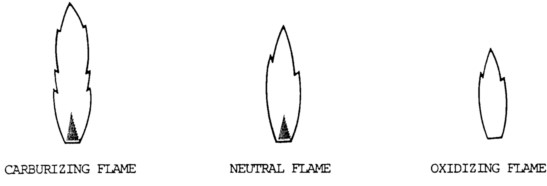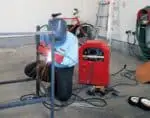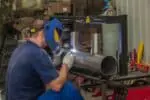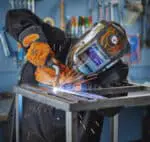Low carbon steels are used in welding for numerous applications. Mild steel is one such low-carbon steel that is quite popular among welders due to its excellent welding characteristics.
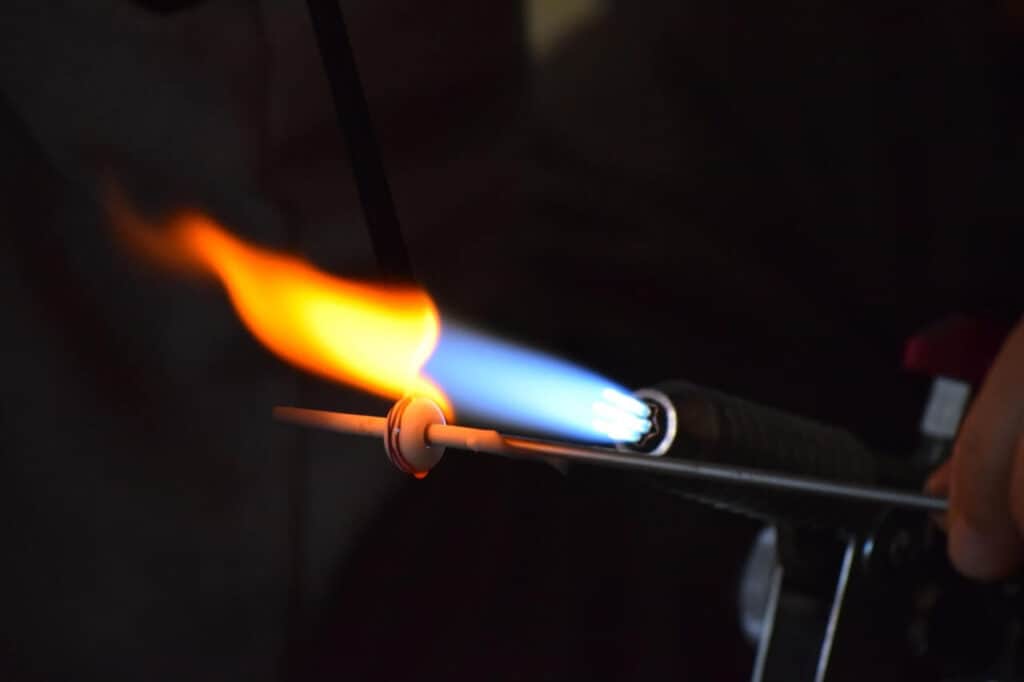 And oxy-acetylene welding is one of the ways adopted to weld mild steel. What we are going to see today is about the flame used for gas welding mild steel and everything about it…
And oxy-acetylene welding is one of the ways adopted to weld mild steel. What we are going to see today is about the flame used for gas welding mild steel and everything about it…
In oxy-acetylene gas welding, the flames come in three types. The one to be used in a particular case is decided by the characteristics of the metal to be welded. For mild steel, a neutral flame is the best choice. This is so because the properties of the flame go well with that of the low-carbon alloy.
For a quick understanding, wade through…
Why use a neutral flame for welding mild steel?
A neutral flame as the name suggests is balanced or neutral in nature. In gas welding, a flame is an essential component to weld metal and the composition of the flame decides the effects on the metal to be welded. Oxygen and Acetylene are the two components that make up the flame.
Mild steel is an alloy that has a low carbon presence. It can go up to 21% and this enhances the quality of iron of the content. Carbon steels tend to be vulnerable to oxidation and corrosion.
Atmospheric conditions tend to make changes in carbon steel making them brittle and rust with time. Heat can also bring similar changes to them.
Mild steel in particular is very susceptible to such changes. In oxy-acetylene welding, the flames come in three forms: Oxidising, Neutral, and Carburizing. Let’s see the combination of the two gases, oxygen, and acetylene in each.
Oxidizing flame: Oxidising flame is created by giving oxygen more preference than acetylene. The flame is louder than the other two and is blue. To reach this flaming condition first the torch should be set in the neutral mode and then make the needed adjustments.
Due to the high content of oxygen, this flame is hotter than neutral and carburizing flame. Thus not all metals will be strong enough to take the effect of the flame making it less preferable.
Moreover, the presence of oxygen in a high amount leads to unveiling oxidizing properties of many metals which are detrimental to the weld.
Neutral flame: Here the quantity of oxygen and acetylene will be the same. The flame is therefore balanced and more receptive to any characteristic metal. This flame is cleaner and less intense than oxidizing flame.
Carburizing flame: Here acetylene takes most of the space leaving the rest for oxygen. The oxygen supply of the neutral flame is reduced to convert it into a carburizing flame. This gives the name ‘reducing flame’.
Unlike the other flames, the outer flame will be brighter with acetylene feathers protruding at the tip. These feathers become smaller when the presence of oxygen is increased.
A carburizing flame creates an effect that is quite frowned upon. When used, it makes some metals absorb carbon making them brittle.
With iron and steel, this reaction produces a substance called iron carbide that affects the health of the metals leaving them hard. This in turn makes them unfit for many applications as they cannot be bent or stretched.
Why neutral flame is the most used in oxy-acetylene welding?
Among the three, mild steel is welded using neutral flame mainly because it is 50% acetylene and 50% oxygen making it easily defined both literally and chemically. The flame is preferred for its inert nature when it comes to dealing with metals.
For mild steel, the tendency to get oxidized and to absorb carbon makes the other two flames a big NO. Both these properties make neutral flame the ideal choice.
Keeping both the gases at bay is the only way to deal with mild steel and the same goes for many others such as cast iron, copper, stainless steel, and aluminum.
A neutral flame is easy to manage and creates less fuss than others. Welders, therefore, try to finish their job with it as much as possible. If the situation demands the neutral flame is slightly adjusted to make the flame favorable for the metal.
How is a neutral flame obtained for welding mild steel?
Making a neutral flame is not an uphill task. A keen eye for the change in color and shape of the flame can make a person an expert in deciding the flame condition.
Opening the oxygen valve is the first step. This will shorten the acetylene flame making it reduce enough for oxygen to exhibit its properties.
When the acetylene flame is reduced, the inner cone becomes more defined and clear. In addition to this, observe the tip of the flame for a better idea.
The more neutral the flame, the lesser will be the streamers or feathers at the end. An ideal neutral flame will therefore be free of both with a clear core.
What are the advantages of using a neutral flame for welding mild steel?
A neutral flame has the following advantages:
1.) No chemical effect leaving no reaction– A neutral flame does not have any chemical properties that can lead to changes in metals when welded. The proposition of oxygen and acetylene balance out each other making it safe to be used with any metal.
2.) Excellent for preheating– Neutral flames are majorly used for preheating the metal during cutting. As the heat is controlled unlike oxidizing flame, neutral flames can work perfectly for preheating.
3.) Keeps the weld pool clean– This pro goes especially for welding steel. A major problem that arises with the smoothness of the procedure is the unclean molten metal pool.
A neutral flame keeps this problem at bay. It gives a molten pool that is clear and quiet ensuring less mess during and after welding. The flow of the metal will be smooth without sparking, boiling, or foaming.
4.) Ensures completes combustion – A neutral flame can absorb additional oxygen from the environment which ensures complete combustion leaving no space for the effect of oxygen on the metal.
5.) Best for other welding methods- Yes, the subtle and quiet characteristics of neutral flame make it ideal for other metal joining methods such as brazing and silver soldering. A neutral flame is therefore quite flexible in terms of its applications.
Tips to remember while welding mild steel using a neutral flame
Here are certain tips that can come in handy while welding mild steel using a neutral flame.
1.) Wear a protective helmet for safety: This goes without saying. No matter the kind of welding procedure that you choose, wearing a protective glass is a must.
Neutral flame might be more controlled than other flames and much safer than other welding methods, yet the rays that are released are harmful to your eyes. Hence, do not forget to wear a welding helmet or protective goggles to keep your eyesight intact.
2.) Keep a clamp for a tight hold: A clamp can become handy if you are going to weld two mild steel pieces. The metal pieces when joined from one end can move away from each other from the other side.
To avoid this you can keep a clamp clasping the other end tightly. This will ensure that the effect of the heat, when dispersed throughout the welding area, does not affect the other parts.
3.) A welding hammer can be a necessity: Another piece of equipment that can be your friend while welding mild steel through oxy-acetylene gas welding.
No matter how expert you are in welding, two pieces, especially sheets, can stay out of proper alignment. After each weld, try to see the alignment and use a hammer to rectify the position.
4.) Hold the torch rightly for a smooth weld: Always hold the torch directly down the line of the weld. This helps for a smooth weld and good visibility. The angle of the torch should always be between 45 degrees to 60 degrees to keep the flame correctly pointed transferring heat at the right amount.
5.) Take breaks to settle the weld: Ensure that you take a 20-second break after a 10-second weld. This gives enough time for the weld to cool and tightens itself. For the good integrity of the weld, giving considerable time in between makes a huge difference.
Check out the video below to see a demo of welding mild steel using oxy-acetylene welding.
Can mild steel be welded without using a flame?
Of course, welding mild steel is not just for oxy-acetylene welding. In fact, mild steel is usually preferred to be welded through other major techniques under arc welding- MIG and TIG. While both methods use welding arcs, there are differences in how the metal filler rod is fed. (Which is the Best Gas to MIG Weld Mild Steel?)
For MIG it is filled automatically by the machine, for TIG it needs to be done manually with hands. Moreover, TIG also requires the welder to use his legs for controlling the foot pedals as well.
But, TIG provides a much cleaner weld than MIG. Thus, when it comes to ease, MIG scores better than TIG, whereas, in terms of weld quality and aesthetics of weld, TIG has an edge over its counterpart. (Can I TIG Weld Mild Steel With Pure Argon?)
To Conclude
The best flame for welding mild steel is therefore neutral flame. It has unique properties and characteristics that make it favorable not just for mild steel but also for other methods, metals, and applications.
Therefore, if you are looking to weld mild steel in gas welding, then the neutral flame is the answer without a second thought.
Hope you had a great time reading this blog post!
More are on the way. Stay tuned!

